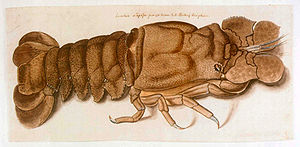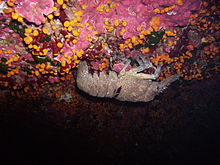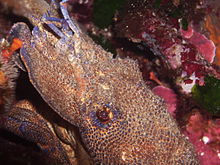Big bear cancer
| Big bear cancer | ||||||||||||
|---|---|---|---|---|---|---|---|---|---|---|---|---|

Scyllarides latus , drawing by Cornelius Sittardus , 1558 |
||||||||||||
| Systematics | ||||||||||||
|
||||||||||||
| Scientific name | ||||||||||||
| Scyllarides latus | ||||||||||||
| ( Latreille , 1803) |
The great bear crab ( Scyllarides latus ) is a type of crustacean from the family of bear crabs (Scyllaridae).
features
The great bear cancer reaches a length of up to 45 centimeters with a compact, stocky and flattened body. The tips of the antenna plates are sharp. When viewed from the back, the segments of the abdomen are laterally tapered. The abdominal segments are laterally covered with strong pointed thorns.
distribution and habitat
The species is found in the Mediterranean (except the northern Adriatic), the eastern Atlantic (Canaries, Azores, West Africa) and in the Red Sea. The great bear cancer inhabits primary and secondary hard soils. It is mainly found in crevices, between boulders and small caves. The depth range is between 4 m and 100 m.
behavior
Scyllarides latus is rarely found in open areas. The species is nocturnal and shy. As a rule, the animals are solitary, but you can also see them in pairs or groups. The vigorous bear cancer is not as sedate as it looks. In case of danger, the animals are able to hit the tail fan under the abdomen in order to catapult themselves backwards in a flash. During the breeding season, the females carry a large number of intensely red-colored eggs that are attached to the hind legs. Brood care is continued until the larvae hatch.
biology
The maximum body length is 45 cm. The basic color is light brown to brownish red, the edges of the leaf-shaped second antennae have a blue-violet border. The first antennae are also blue-violet. In the Mediterranean there are two genera with five species of the slippery shrimp family. A confusion with representatives of the other five species is not given in Scyllarides latus due to the appearance and size.
Aquaristics
Due to the size and the specific housing characteristics, the animals are only suitable for species-appropriate show aquariums. Normal homecoming is not recommended.
Culinary importance
Big slippery lobsters are interesting for human consumption because of their firm, tasty meat. They are easy to peel. Bear shrimp can be grilled, fried, sautéed, baked, boiled or steamed. They have a few small spines that can cause very painful stings, especially when uncooked.
literature
- Matthias Bergbauer, Bernd Humberg: What lives in the Mediterranean? . Franckh-Kosmos Verlag, Stuttgart 2009
- Yves Paccalet, Sophie de Wilde: Mediterranean Encyclopedia of the Underwater World . Year publisher, Hamburg 1994
- Peter Hayward, Tony Nelson-Smith, Chris Shields: The New Cosmos Beach Guide . Franckh-Kosmos Verlag, Stuttgart 2007, ISBN 978-3-440-10782-9 , p. 152.
Web links
- http://www.marinespecies.org/aphia.php?p=taxdetails&id=107708
- http://www.meerwasser-lexikon.de/tiere/2608_Scyllarides_latus.htm
- Scyllarides latus inthe IUCN 2013 Red List of Threatened Species . Posted By: Butler, M., MacDiarmid, A. & Cockcroft, A., 2009. Retrieved January 20, 2014.
Individual evidence
- ↑ http://www.marinespecies.org/aphia.php?p=taxdetails&id=107708
- ↑ a b c Matthias Bergbauer, Bernd Humberg: What lives in the Mediterranean? . Franckh-Kosmos Verlag, Stuttgart 2009
- ↑ http://www.meerwasser-lexikon.de/tiere/2608_Scyllarides_latus.htm


